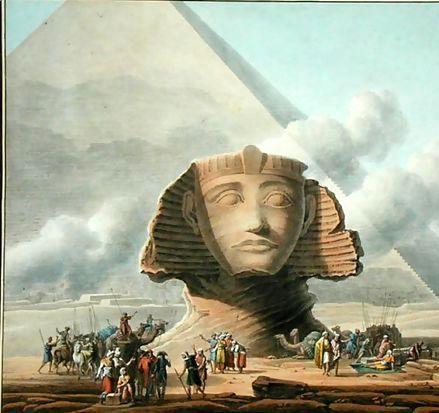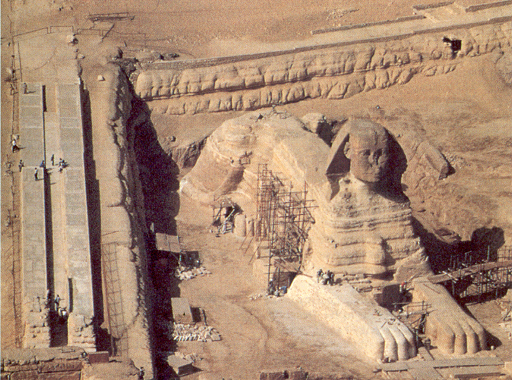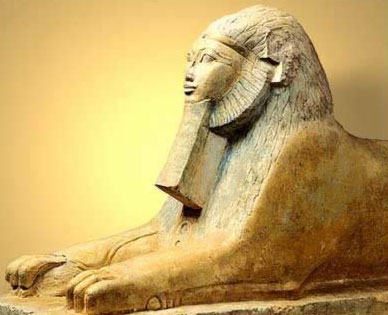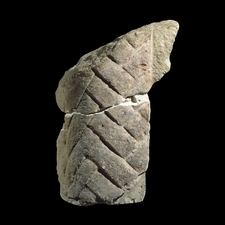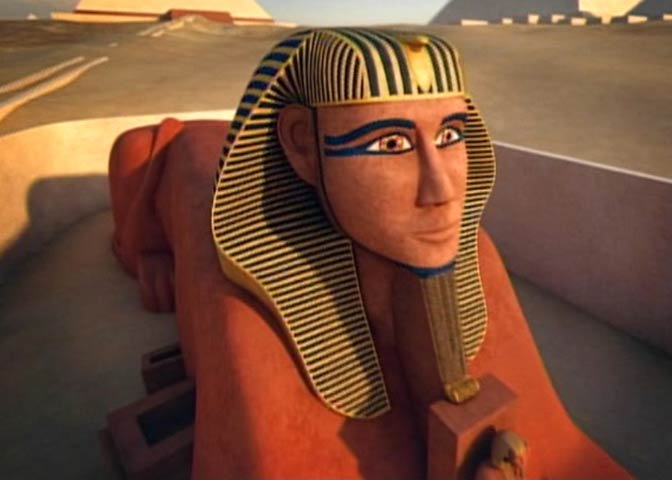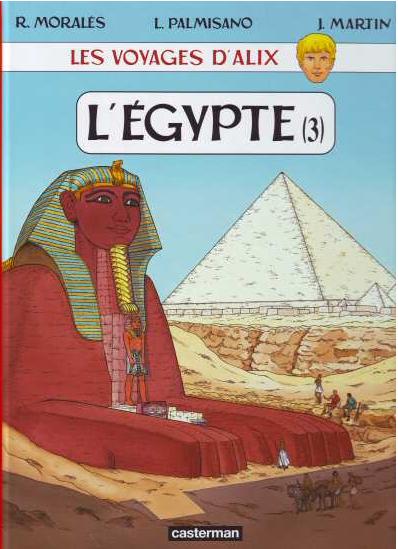The Sphinx: Bushed, Plumed and Painted January 8, 2014
Author: Beach Combing | in : Ancient , trackbackThe Sphinx needs no introduction. The vast majority of educated people would be able to close their eyes and visualise his face almost perfectly, not least because of his use as an icon for antiquity and for Egypt and even for mysticism. But when we imagine the Sphinx in our mind’s eye we, of course, see an imperfect face. Bits have been falling off the Sphinx for a long time. Contrary to that much told legend, it was not Napoleonic soldiers that shot the nose off (another bit of cobblers to add to Napoleon in the pyramid), but some earlier vandals that climbed up with chisels. The head-dress is fragile and fragments have been known to drop: including a large piece in 1926. But even if all these objects could be restored we would still not see the Sphinx as it was in the days of Pharoah Kaphre (2520–2492 BC): the Sphinx is usually said to have Kaphre’s face, certainly it is wearing a pharoah’s insignia.
First above the head-dress there is a hole (now filled in) that was presumably used to hold a further object: it has been suggested, massive feathers. Imagine ostrich plumes. Photo-shop experts please get in touch. The temptation to add some feathers here is strong.
The second missing object is the pharoah’s beard. A beard was not part of the sculpture: possibly because it was too difficult to carve. But a beard was, at some point, added and tied around the chin, just as the pharoahs had their precious ceremonial beards knotted into place.
This beard is no longer at the Sphynx – in fact, half of it is no longer in Egypt! – but most of the smashed beard was recovered from the sands. One large part was taken to London, it is in the British Museum, another part is kept in a back room in the Ancient Egyptian museum in Cairo for visiting scholars to trip over. Now there surely is a project, the reuniting of the beard and it being retied to the face of its owner?
The final difference with the sphinx as we imagine it today was that it was at some point painted: someone should work out how many cubic metres of sloshing colour that it. Red flecks on the face suggest a ruddy complexion and there was blue and gold on the headdress. The charismatic limestone of today provides a satisfyingly Ozymandias vibe for we moderns. For the ancient Egyptians – as with the Greeks and Romans – statues without paint just didn’t cut it: think black and white films for the internet generation.
Now it is not certain that any of these three aspects were original. The beard, it is often and persuasively argued, dated to a later phase of Egyptian history: it is braided as in the time of Tutankhamun (obit 1327 BC). (Though there may have been an earlier beard, which was attached and then disposed of when it went out of fashion).
The hole on the top of the head with plumes or other objects may have been added afterwards, too, in the same way the hole was filled in afterwards. The paint could have come from one of the ancient rennovations. But there was probably a time when you arrived at Giza only to be be confronted by a great, gaudily coloured bearded behemoth with huge feathers above it wafting in the Nile winds.
I’ll never be able to look at the sphinx again in the same way: I wish the same for my readers. Any other ancient monuments or figures that actually looked rather different from the popular images of today? drbeachcombing AT yahoo DOT com
8 Jan 2014: Ruththeunstoppablycurious refers to other objects painted in the past bare today. ‘There was, of course, the Parthenon. You can find Nefertiti all over the place, for as low as $29.95 Though that one just doesn’t look quite right. I seem to be finding a lot of variations. A discussion: A Smithsonian article on true colors on ancient monuments & statues. Even knowing that they are extrapolating from very little information, like specks of paint in crevices, I still love to see the digital reconstructions.’ Thanks Ruth
8 Jan 2014: Lehmansterms writes ‘I had an immediate image appear in the mind’s eye when you asked for examples of other “…monuments or figures that actually looked rather different…”. If I might take some liberties with both the beginning and end of your phrase as well as what was perhaps your precise original intent, I would suggest “The Old Man of the Mountain” on the side of Cannon Mt. In Franconia Notch, New Hampshire. I wish to draw your attention to it not even because of the substantiality of “change” it has undergone by way of completely falling off the mountain on May 3, 2003, although that certainly is a major change. The change to which I refer is that which had occurred in the face – a natural feature, not a carving – before the time it was first mentioned by Westerners in 1805. It is remembered – particularly by those of us who live in New England and had occasion to see it repeatedly as the stern, elderly visage reproduced on all manner of souvenirs. This profile was also adopted as the state emblem and used as the device for the reverse of the 2000 New Hampshire statehood commemorative quarter-dollar coin. Many of us had the opportunity to gaze upon it thus and contemplate it for some hours at a time while Interstate Highway 93 was being completed through the notch in the 1970’s. Construction often brought all north-south traffic in the area to a complete and extended standstill – often lasting hours – over a period of a couple of years. As for changes in years gone by, according to one story I heard, the native Americans in the area had originally known it as the face of a young maiden. Then, as the story went, at the coming of the White Man, the smiling face of the young woman changed into the stern, elderly visage by which it is remembered so well – particularly by those of us who live in New England and saw it a lot. There is also a popular book with an invented bit of folklore about a Pemigewasset indian maiden and her starcrossed lover’s run-in with her father the chief, etc… Geologic action of the sort which eventually brought it down was responsible for the change in the face from maiden to old man. Perhaps even more interesting is the series of memorials to the monument, both realized and envisiged, capturing its essence without attempting to re-create it. This from wikipedia: On the first anniversary of the collapse in May 2004, the Old Man of the Mountain Legacy Fund (OMMLF) began operating coin-operated viewfinders near the base of the cliff. When looking through them up at the cliff of Cannon Mountain one can see a “before” and “after” of how the Old Man of the Mountain used to appear. Seven years after the collapse, on June 24, 2010, the OMMLF, now the Friends of the Old Man of the Mountain, broke ground for the first phase of the state-sanctioned “Old Man of the Mountain Memorial” to be located on an improved walkway along Profile Lake below Cannon Cliff. The first phase consists of a viewing platform with “Steel Profilers”, which, when aligned with the Cannon Cliff above, create what the profile looked like up on the cliff overlooking the Franconia Notch. The second phase will include a “Granite Gateway” with tribute to the Nielsen family and others who maintained the profile over the last century. It will also include a remnant of the turnbuckle tie rod that supported the uppermost ledge. In the third and final phase, five large “Granite Monoliths” will be lifted in alignment which when viewed from ground level will merge, creating a 20-foot-tall (6.1 m) profile replica of the five ledges that generated the original profile. The project is being overseen by Friends of the Old Man of the Mountain/Franconia Notch, a committee that succeeded the Old Man of the Mountain Revitalization Task Force. The Legacy Fund is a private 501(c)(3) corporation with representatives from various state agencies and several private nonprofits. Other proposals included one from architect Francis Treves, which won an American Institute of Architects Un-Built Project Award. It envisioned a walk-in profile made of 250 panels of structural glass attached to tubular steel framework and concrete tower, connected by a tram, rim trail or tunnel through to the cliff wall at the original site. In 2009, Kenneth Gidge, a state representative from Nashua, proposed building a copper replica of the Old Man on level ground above the ledge at the original site where hiking trails already lead. That idea was rejected. So, interestingly, even when monuments no longer exist anywhere but in memory and on souvenirs, humans seem irresistably drawn to the creation of continuous generations of changing views of those images.’ thanks, Lehmansterms!
9 Jan 2014: CH writes ‘While I’m sure we’ve all heard various theories about the origins of the Sphinx, ranging from the intriguing to the downright bizarre (and conveniently impossible to prove), one thing has always struck me as strange: the head is not in proportion with the body, even once possibly missing pieces are considered. I find it altogether plausible that in its original form it was a lion with full mane that got re-purposed for personal Pharoanic purposes….and if the head/face was remodeled more than once, that would go a fair way to explain the issue of proportion. Remember, Egyptian sculptures are on the whole stunningly exact…why the exception for the Sphinx? Kings love to leave their mark (and take credit for just about everything), and if there’s a statue close to hand that will do the trick at a fraction of the cost and effort of building another from scratch, well then so be it! I’m not sure we’ll ever really know. As for ‘aliens’, nothing short of a glyph saying ‘Zaphod was here!’ will be truly convincing.’ Thanks CH!
9 Jan 2014: NH writes in: There are, at least, two busts of Nefertiti. The rather gaudily painted one is in the Berlin Museum. That’s the one of which there are even more gaudy reproductions (Wikipedia page). There is an unpainted incomplete version, which I much prefer, in the Cairo Musuem. The Cairo version may be similar as the carved stone core for the Berlin one which is covered with stucco, and then painted. Thanks NH!
9 Jan 2014: Louis writes, Reading your post, i was reminded of the comic book series Les voyages d’Alix, by Jacques Martin. In this series the artist has recreated a lot of the sites of antiquity, and Egypt (and the sfinx) is one of them. Martin apparently started the series after a visit to Greece, where he missed a visual recreation of all the monuments that he visited. After talking to an Archaeologist friend, he was told that they, as archaeologists, could not, or were not allowed to, do this, and that he, Martin, would be the best person to do this as his original series about Alix already featured a lot of antique background (the setting is at the time of Ceasar). So Martin then set out to do just that…. Thanks Louis and picture below
10 Jan 2014: NH continues: In answer to your question. Any other ancient monuments or figures that actually looked rather different from the popular images of today? The fundamental answer, at least for parochial England, is – just about everything. The word is “polychrome”. Just about everything in our churches before 1500 was painted, as would any other significant public or private art. The people we have to thanks for our monochrome churches are the iconoclastic puritans reformers and for statuary the Renaissance, as by the time they were discovered the previously painted Greek & Roman statues no longer showed their paint, plus the development of metal statuary, which is more difficult to paint. For monuments in Britain we don’t know, but the concept that Avebury or Stonehenge were always just dour stone seems highly unlikely. We do know that medieval castles were painted, such as the prominent keep of Corfe Castle. Thanks NH!

